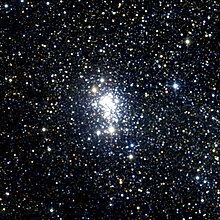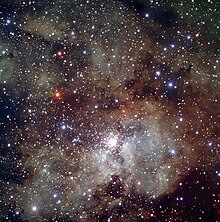Super star cluster
A super star cluster (SSC) is a very massive young open cluster that is thought to be the precursor of a globular cluster.[1] These clusters are referred to as "super" due to the fact that they are relatively much larger, more luminous, and contain more mass than other young star clusters.[2] They typically contain a very large number of young, massive stars that ionize a surrounding H II region, similar to the Milky Way Galaxy's so-called "Ultra dense H II regions (UDHIIs)".[3] An SSC's H II region is in turn surrounded by a cocoon of dust. In many cases, the stars and the H II regions will be invisible to optical observations due to high levels of extinction. As a result, the youngest SSCs are best observed in radio and infrared.[4]
The Typical characteristics of SSCs:
- large electron densities – cm
- pressures – K cm.[4]
- Mass 5M☉[2]
- Radius ≈ 5 pc ≈ cm[2]
- Age ≈ 100Myr[2]
List
| Name | Galaxy | Comments | Notes | Pictures |
|---|---|---|---|---|
| Westerlund 1 (Wd1) | Milky Way Galaxy | First SSC discovered in the Milky Way Galaxy. | [5] |  |
| NGC 3603 | Milky Way Galaxy | [6] |  | |
| R136 | Large Magellanic Cloud (LMC) | The prototype SSC | [7] |  |
| NGC 1569 A1 and A2 | NGC 1569 | Galaxy contains two SSCs | [8] |  |
References
- ^ Gallagher; Grebel (2002). "Extragalactic Star Clusters: Speculations on the Future". Extragalactic Star Clusters, IAU Symposium. 207: 207. arXiv:astro-ph/0109052. Bibcode:2002IAUS..207..745G.
{{cite journal}}: Unknown parameter|last-author-amp=ignored (|name-list-style=suggested) (help) - ^ a b c d Johnson, Kelsey. "The Properties of Super Star Clusters In A Sample of Starburst Galaxies" (PDF).
{{cite journal}}: Cite journal requires|journal=(help) - ^ Kobulnicky, Henry A.; Johnson, Kelsey E. (1999). "Signatures of the Youngest Starbursts: Optically Thick Thermal Bremsstrahlung Radio Sources in Henize 2-10". ApJ. 527 (1): 154–166. arXiv:astro-ph/9907233. Bibcode:1999ApJ...527..154K. doi:10.1086/308075.
{{cite journal}}: Unknown parameter|last-author-amp=ignored (|name-list-style=suggested) (help) - ^ a b Johnson (2004). "Extragalactic Ultracompact HII Regions: Probing the Birth Environments of Super Star Clusters". ASP Conference Series. 527: 322. arXiv:astro-ph/0405125. Bibcode:2004ASPC..322..339J.
- ^ Clark, J. S.; Negueruela, I.; Crowther, P. A.; Goodwin, S. P. (2005). "On the massive stellar population of the super star cluster Westerlund 1". Astronomy and Astrophysics. 434 (3): 949. arXiv:astro-ph/0504342. Bibcode:2005A&A...434..949C. doi:10.1051/0004-6361:20042413.
- ^ Fukui, Y.; Ohama, A.; Hanaoka, N.; Furukawa, N.; Torii, K.; Dawson, J. R.; Mizuno, N.; Hasegawa, K.; Fukuda, T.; Soga, S.; Moribe, N.; Kuroda, Y.; Hayakawa, T.; Kawamura, A.; Kuwahara, T.; Yamamoto, H.; Okuda, T.; Onishi, T.; Maezawa, H.; Mizuno, A. (2014). "Molecular Clouds Toward the Super Star Cluster Ngc 3603; Possible Evidence for a Cloud-Cloud Collision in Triggering the Cluster Formation". The Astrophysical Journal. 780: 36. arXiv:1306.2090. Bibcode:2014ApJ...780...36F. doi:10.1088/0004-637X/780/1/36.
- ^ Massey, Philip; Hunter, Deidre A. (1998). "Star Formation in R136: A Cluster of O3 Stars Revealed by Hubble Space Telescope Spectroscopy". The Astrophysical Journal. 493: 180. Bibcode:1998ApJ...493..180M. doi:10.1086/305126.
- ^ Hunter, Deidre A.; O'Connell, Robert W.; Gallagher, J. S.; Smecker-Hane, Tammy A. (2000). "The Star Clusters in the Starburst Irregular Galaxy NGC 1569". The Astronomical Journal. 120 (5): 2383. arXiv:astro-ph/0009280. Bibcode:2000AJ....120.2383H. doi:10.1086/316810.









